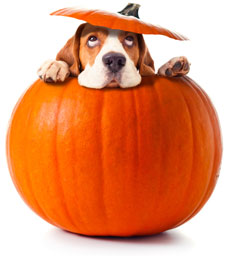Is Pumpkin Good for Dogs?

Most dogs are quite food-oriented and love to be given some "people food" from time to time. We must be cautious when giving human foods to our dogs because they can cause gastrointestinal irritation or even be toxic. However, one human food with surprising health benefits for dogs is pumpkin.
Potential Benefits of Pumpkin for Dogs
-
Fiber: One of the key nutritional qualities of pumpkins is that it is rich in fiber (the material from plants that cannot be broken down by enzymes in the body). It can have up to five grams of fiber per ½ cup serving (122 gm) and is also rich in moisture. Some of the ways fiber is beneficial to dogs are as follows:
- Weight control: Fiber promotes a "feeling of fullness" even if fewer calories are being taken in. This can potentially aid in weight loss due to decreasing the physiological need to eat more food; , but as with all dietary plans, consult your veterinarian first about your dog's specific needs.
-
Treatment of Diarrhea: Pumpkin contains soluble fiber and this can absorb excess water in the digestive tract, reducing or relieving diarrhea.
Consult with your veterinarian if your dog has diarrhea for longer than 24 hours or immediately if it is accompanied by any other signs of illness.
- Constipation: Conversely, a pumpkin's high fiber content can act as a laxative, which is a good thing because you want the GI tract to keep moving in a regular pattern. The combination of fiber and moisture can be of great benefit in creating bulk that stimulates bowel movements.
-
High Nutrient Content: Pumpkin is packed with nutrients that are beneficial for various bodily systems in dogs.
- Vitamin A helps maintain immune system and vision.
- Vitamin C is a cofactor for enzymatic reactions and collagen synthesis.
- Vitamin E is a fat soluble antioxidant and enzymatic activity regulator.
- Alpha carotene is an antioxidant that prevents damage to cells.
- Calcium supports cytoplasmic functions and mineralizes bone and teeth.
- Iron contributes to cellular respiration, oxidation, and hemoglobin production.
- Lutein supports the health of the eyes, skin, and coat.
How to Feed Pumpkin to Dogs
Don't feed:
- The stem: it is prickly and rough on the digestive tract.
- The skin may not digest well.
- Pulp: don't feed the soft gooey material in the center.
- Raw pumpkin.
- Canned or fresh pumpkin or pie filling with additives, fillers, spices, or sugar.
- Jack-O-Lantern that has been cut and left out. Molds or bacteria may have grown on these pumpkins, and that will cause illness in dogs.
What to feed:
- Fresh seeds can be fed, but clean and roast them at
350 °F for1 hour first. Do not add any salt or spices. The shelf life for dry roasted seeds is less than a month. Grind the seeds before adding them to food. - 100% canned pumpkin without additives, fillers, spices, or sugar.
- Fresh pumpkin that has been baked until soft. Remove the seeds, and allow the pumpkin to cool before feeding.
How Much Pumpkin to Feed Your Dog
- Discuss the following recommendations with your veterinarian.
- Use a level measuring spoon to ensure that you are using the right amount.
- Adult small dogs: 1/2 teaspoon - 1 teaspoon pumpkin daily.
- Adult medium dogs: 1 tablespoon pumpkin daily.
- Adult large dogs: 1 1/2 to 2 tablespoons pumpkin daily.
-
Pumpkin seeds:
- -Adult small dogs: (
10 lbs. and over) 1/16 to 1/8 teaspoon daily. - -Adult medium dogs: 1/4 to 1/2 teaspoon daily.
- -Adult large dogs: 1/2 to 1 teaspoon daily.
- -Adult small dogs: (
Most dogs find pumpkin highly palatable.
At every step of the process of introducing pumpkin into your dog's diet, be mindful of the activity of the GI tract and the firmness and frequency of the stools.
How to Preserve Pumpkin
- If you use it quickly, use a pet food can lid and refrigerate the extra.
- If you use it slowly, portion it into an ice cube tray and freeze it (this is good for fresh or canned pumpkin). The pumpkin can be defrosted daily as you need it.
- Pumpkin will spoil if it is at room temperature for an extended time.
It is often thought that more of a good thing is better. In this case, that isn't true. Too much pumpkin can result in destabilization of the GI tract. Pumpkin is a natural laxative. Remember to check with your veterinarian and err on the side of caution: start with less, and work up the amount as needed. Ensure that your dog always has plenty of fresh, clean water.
You May Also Like These Articles:
Foods Toxic to Dogs - Slideshow
Springtime Hazards for Dogs - Slideshow
Walking Your Dog to Help with Weight Loss
Dog Weight Loss: Tips For Helping Your Dog Lose Weight
Sago Palms Are Extremely Toxic to Dogs
Disclaimer: This website is not intended to replace professional consultation, diagnosis, or treatment by a licensed veterinarian. If you require any veterinary related advice, contact your veterinarian promptly. Information at DogHealth.com is exclusively of a general reference nature. Do not disregard veterinary advice or delay treatment as a result of accessing information at this site. Just Answer is an external service not affiliated with DogHealth.com.
Notice: Ask-a-Vet is an affiliated service for those who wish to speak with a veterinary professional about their pet's specific condition. Initially, a bot will ask questions to determine the general nature of your concern. Then, you will be transferred to a human. There is a charge for the service if you choose to connect to a veterinarian. Ask-a-Vet is not manned by the staff or owners of DogHealth.com, and the advice given should not delay or replace a visit to your veterinarian.



